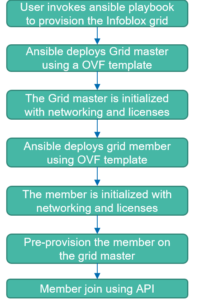Introduction:
Infoblox Grid deployment on VMware vCenter server involves numerous manual steps. Firstly, the vNIOS ova must be manually deployed, post this, steps like license assignment and networking which by the way also requires reboot must be performed. This complete process is highly manual and time consuming. Also, if Grid involves multiple members number of manual steps and grid deployment time increases exponentially.
This blog talks about automating grid deployment process and eliminating manual tasks with the help of ansible.
Deploying Infoblox grid using ansible
Automation through Ansible simplifies complex IT tasks, thereby not just making developer’s and system administrator’s jobs more manageable but allowing them to focus on other tasks that add value to an organization. In other words, it frees up time and increases efficiency. Ansible uses a simple syntax written in YAML called playbooks. YAML is a human-readable data serialization language. It is incredibly simple.
Infoblox Grid deployment automation on VMware vCenter server is achieved through Zero Touch Provisioning(ZTP) ansible playbook.
ZTP play book leverages following ansible native modules
| Module Name | Functionality |
|---|---|
| vmware_deploy_ovf | Deploys VM off an ovf file. This module deploys vnios on vCenter server. |
| vmware_guest | Modifies VMs on vCenter server. This module modifies vnios resources. |
| nios_member | This module is developed by Infoblox. It provisions offline members in Grid master. |
| Uri | Interacts with Infoblox REST APIs. This module leverages Infoblox WAPIs to add members to the Grid master. |
Workflow:
Once vNIOS ZTP playbook is invoked, it executes a series of steps which are summarized in the following workflow.

Initialization of grid master and members is achieved through cloud-init.
vNIOS ZTP ansible playbook is shipped with a feeder file in .ini format. This feeder file must be populated with details of the Grid to be deployed like IP addresses of Grid master and members, resources details for Grid master and members. vNIOS ZTP playbook reads the values from feeder while deployment.
Post invocation, vNIOS ZTP prompts the user to provide license details for Grid master and members. Having two separate prompts for the licenses, enables the user to apply different set of licenses to Grid master and members.

Downloading vNIOS ZTP ansible playbook.
vNIOS ZTP playbook can be downloaded from https://github.com/infobloxopen/vnios_ztp_vmware. Users can refer README.md file for detailed instructions and prerequisites.
Conclusion
Infoblox Grid deployment automation through ansible speeds up the deployment process. It streamlines the deployment process and automates manual mundane tasks.





